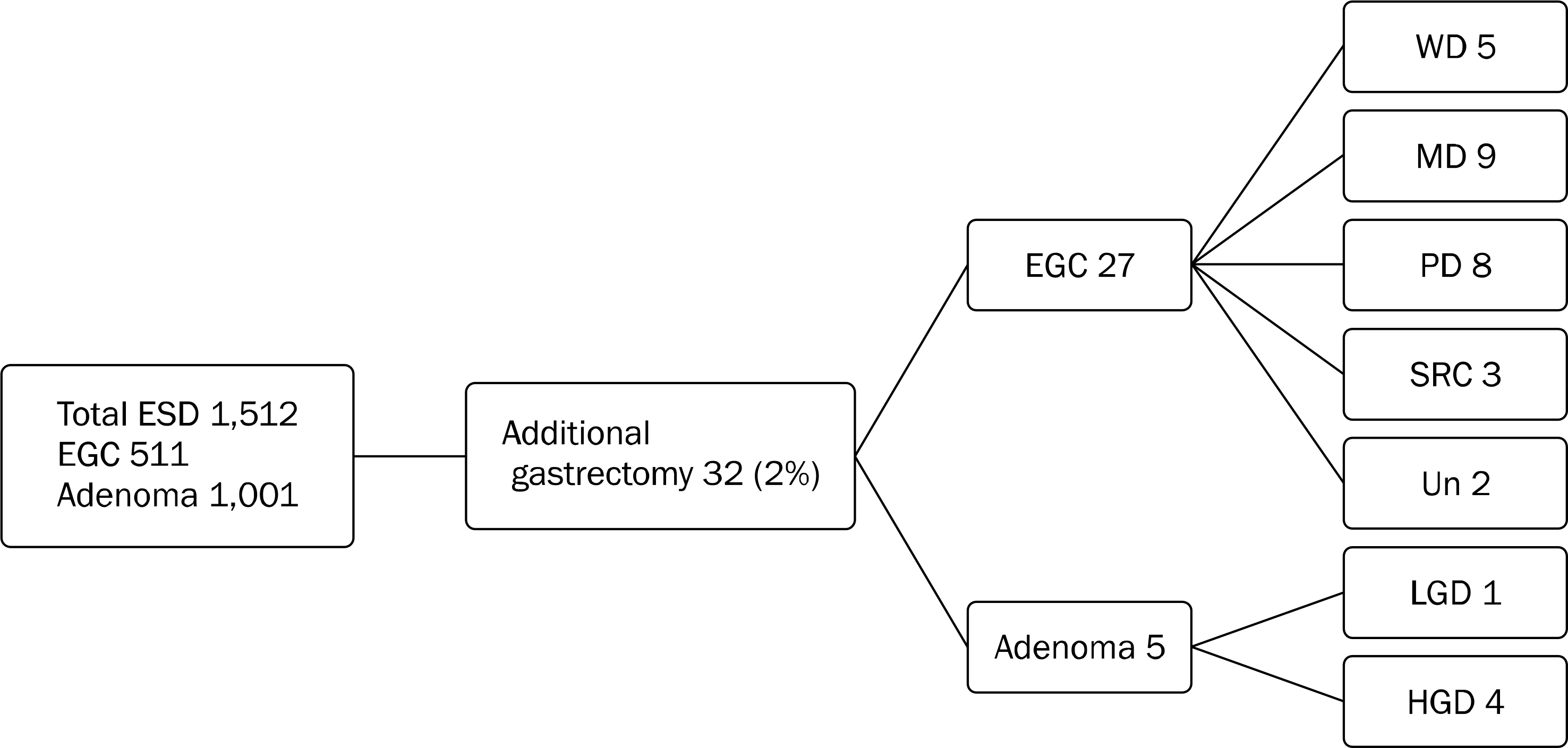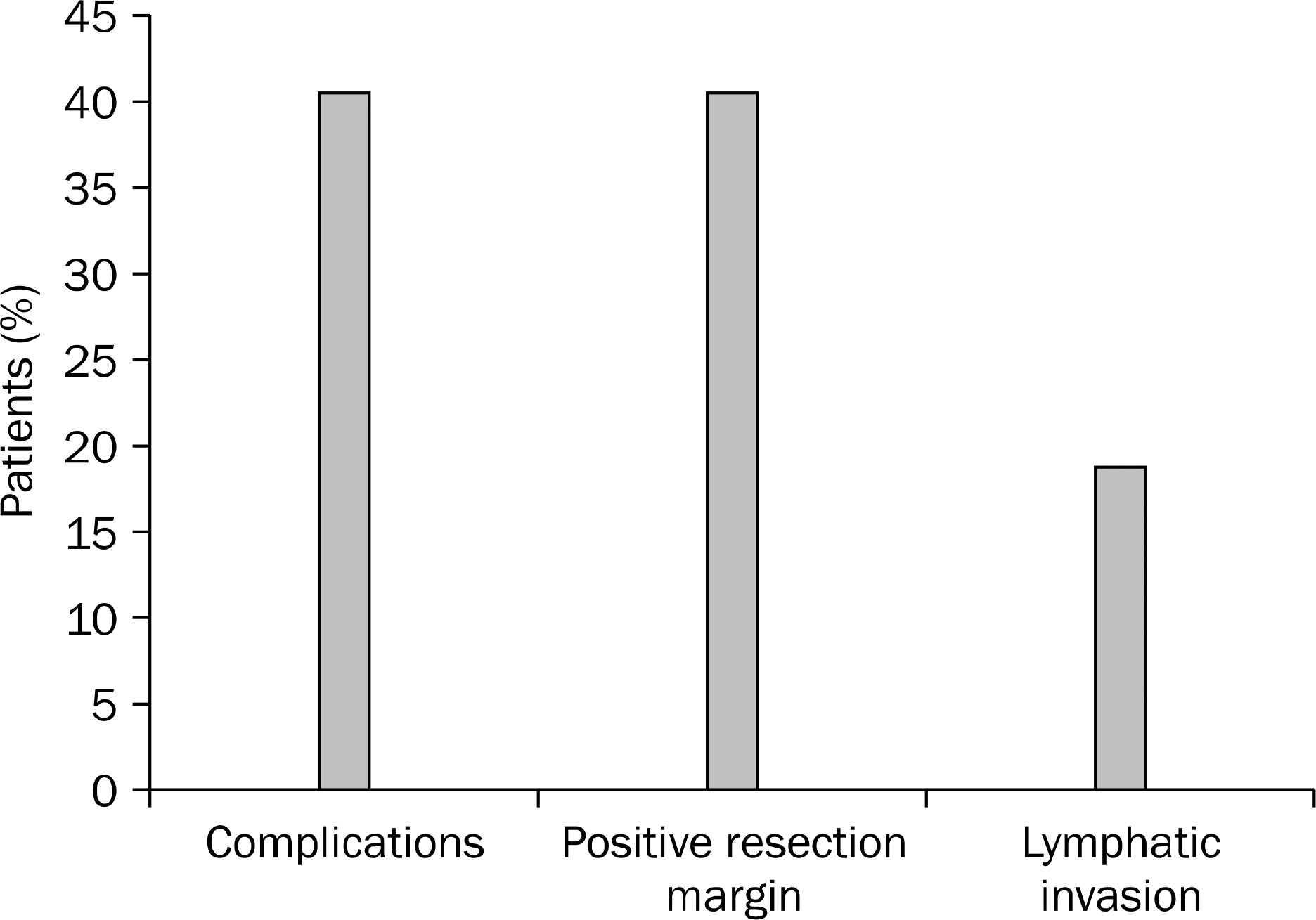Abstract
Background/Aims
Endoscopic submucosal dissection (ESD) has been widely performed. However, procedure related-complications and the risk of tumor recurrence are limitations. We analyzed the clinicopathological characteristics of patients who underwent curative additional gastrectomy (gastrectomy) after ESD.
Methods
The clinical characteristics of cases underwent gastrectomy after ESD were retrospectively analyzed.
Results
Between January 2002 and August 2010, 1,512 cases underwent ESD for early gastric cancer (n=511) or adenoma (n=1,001). Thirty-two cases (2.1%) underwent gastrectomy after ESD. Thirty cases (2.0%) were EGC and 2 cases (0.1%) were adenoma. Extended indication, larger tumor size and piecemeal resection were risk factors for gastrectomy after ESD. According to the causes of gastrectomy, 13 cases underwent gastrectomy due to complications (40.6%; bleeding in 9, perforation in 4), and 19 cases based on pathological results (incomplete resection in 13, lymphatic invasion in 6). In cases with incomplete resection, the rate of residual tumor and lymph node metastasis after gastrectomy was 69.2% (75% lateral margin, 60% deep and 75% both) and 7.7%, respectively. Three (50%) of the 6 cases with lymphatic invasion had lymph node metatstasis.
Go to : 
References
2. Gotoda T, Yanagisawa A, Sasako M, et al. Incidence of lymph node metastasis from early gastric cancer: estimation with a large number of cases at two large centers. Gastric Cancer. 2000; 3:219–225.

3. Gunji Y, Suzuki T, Hori S, et al. Prognostic significance of the number of metastatic lymph nodes in early gastric cancer. Dig Surg. 2003; 20:148–153.

4. Oka S, Tanaka S, Kaneko I, et al. Advantage of endoscopic submucosal dissection compared with EMR for early gastric cancer. Gastrointest Endosc. 2006; 64:877–883.

5. Kim JJ, Lee JH, Jung HY, et al. EMR for early gastric cancer in Korea: a multicenter retrospective study. Gastrointest Endosc. 2007; 66:693–700.
6. Bae JM, Kim SW, Kim SW, Song SK. Clinicopathological characteristics of patients who received additional gastrectomy after endoscopic resection due to gastric cancer. J Korean Surg Soc. 2010; 78:87–92.

7. Kim JJ, Kim BJ. Current status of endoscopic mucosal resection for early gastric cancer in Korea. Korean J Med. 2009; 76:291–295.
8. Ono H, Kondo H, Gotoda T, et al. Endoscopic mucosal resection for treatment of early gastric cancer. Gut. 2001; 48:225–229.

9. Oda I, Gotoda T, Sasako M, et al. Treatment strategy after non-cu-rative endoscopic resection of early gastric cancer. Br J Surg. 2008; 95:1495–1500.

10. Manner H, Rabenstein T, May A, et al. Longterm results of endoscopic resection in early gastric cancer: the Western experience. Am J Gastroenterol. 2009; 104:566–573.

11. Kim HO, Choi WB, Shin JH, Yoo CH. An investigation of patients who have undergone curative gastrectomy after incomplete endoscopic mucosal resection with a diagnosis of early gastric xancer. J Korean Surg Soc. 2008; 74:187–191.
12. Jung H, Bae JM, Choi MG, Noh JH, Sohn TS, Kim S. Surgical outcome after incomplete endoscopic submucosal dissection of gastric cancer. Br J Surg. 2011; 98:73–78.

13. Yasuda K. EUS in the detection of early gastric cancer. Gastrointest Endosc. 2002; 56(4 Suppl):S68–S75.

14. Lee TH, Cho JY, Chang YW, et al. Appropriate indications for endoscopic submucosal dissection of early gastric cancer according to tumor size and histologic type. Gastrointest Endosc. 2010; 71:920–926.

15. Cho YK, Cho JY, Jin SY, et al. Comparison of the cut direction between gross finding, streoscopic finding, and pathologic mapping of endoscopic submucosal dissection Specimen. Korean J Gastroenterol. 2010; 56:293–298.

Go to : 
 | Fig. 1.Baseline pathologic findings before ESD. ESD, endoscopic submucosal dissection; EGC, early gastric cancer; WD, well differentiated adeno-carcinoma; MD, moderately differentiated adenocarcinoma; PD, poorly differentiated adnocarcinoma; SRC, signet ring cell carcinoma; Un, un-known; LGD, low grade dysplasia; HGD, high grade dysplasia. |
Table 1.
Risk Factors of Additional Gastrectomy after ESD
Table 2.
Baseline Characteristics of Patients Who Had Additional Gastrectomy according to Indications of Operation
Table 3.
Post Operation Pathological Findings of 32 Patients Who Had Additional Gastrectomy




 PDF
PDF ePub
ePub Citation
Citation Print
Print



 XML Download
XML Download